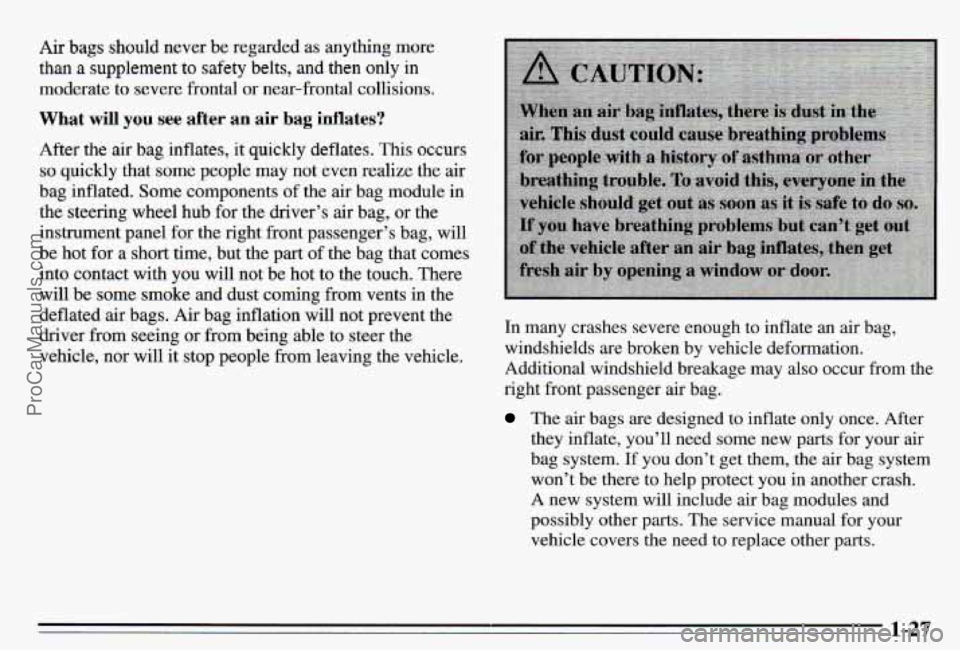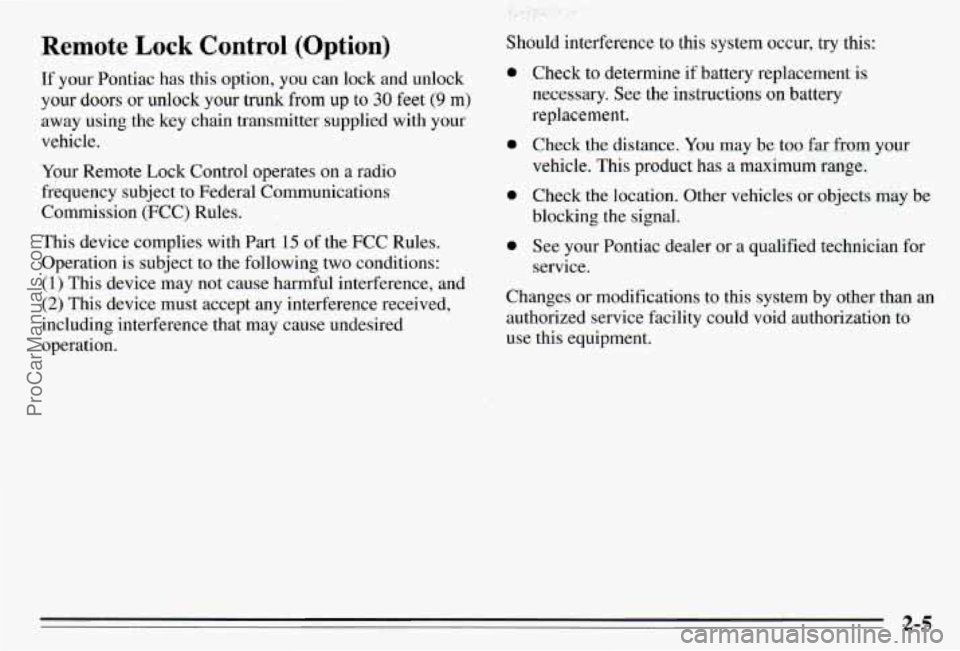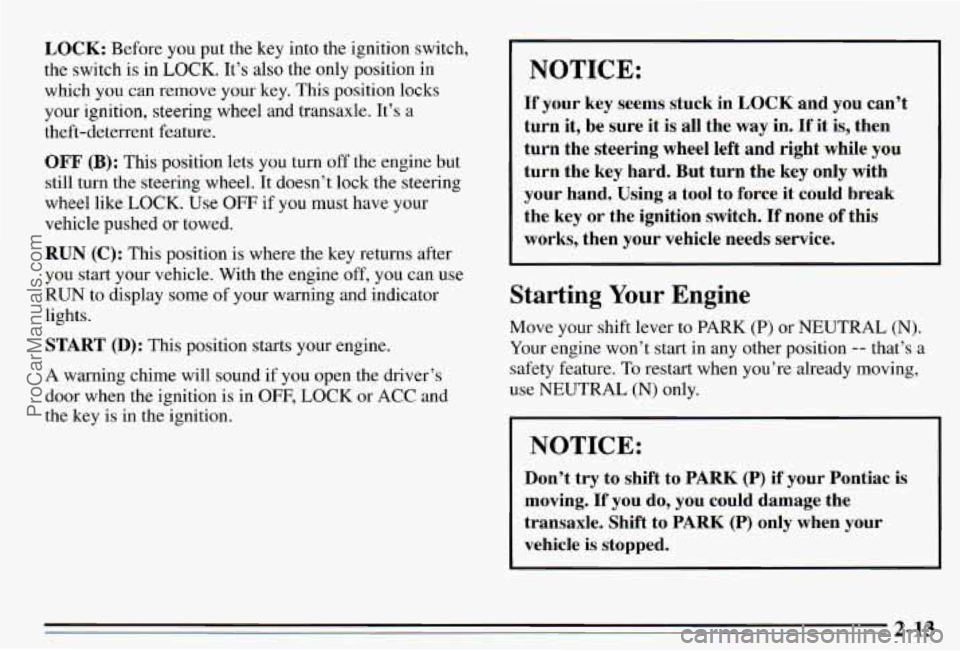1995 PONTIAC PONTIAC service
[x] Cancel search: servicePage 2 of 354

1995 Pontiac Grand Prix Owner’s Manual
Seats and Restraint Systems ...... F.-c-.,. ............................................... 1-1
This section tells you how to use your seats and safety belts prop\
erly. It also explains the “SRS” system.
Features and Controls ............................................................... 2-1
This section explains how to start and operate your Pontiac.
Comfort Controls and Audio Systems .................................................. 3-1
This section tells you how to adjust the ventilation and comfort controls and how to operate your
audio system.
YourDrivingandtheRoad ........................................................... 4-1
ProblernsontheRoad ............................................................... 5-1
Here you’ll find helpful information and tips about the road\
and how to drive under different conditions.
This section tells you what to
do if you have a problem while driving, such as a flat tire or engine
overheating, etc.
Here the manual tells you how to keep your Pontiac running properly and looking good.
This section tells you when to perform vehicle maintenance and \
what fluids and lubricants
to use.
This section tells you how to contact Pontiac for assistance and how to get service publications.
It
also gives you information on “Reporting Safety Defects” on pag\
e 8-4.
Here’s an alphabetical listing of almost every subject in this manual. You can use it to quickly find
something you want to read.
Service and Appearance Care.. ....................................................... 6-1
Maintenanceschedule ............................................................... 7-1
Customer Assistance Information ..................................................... 8-1
Index ........................................................................\
..... 9-1
i
ProCarManuals.com
Page 3 of 354

-
GM
GENERAL MOTORS, GM and the GM Emblem,
PONTIAC and the PONTIAC Emblem are registered
trademarks of General Motors Corporation.
This manual includes the latest information at the time it
was printed. We reserve the right to make changes in the
product after that time without further notice. For
vehicles first sold in Canada, substitute the name “General Motors
of Canada Limited” for Pontiac
Division whenever it appears in this manual.
Please keep this manual in your Pontiac,
so it will be
there
if you ever need it when you’re on the road. If you
sell the vehicle, please leave this manual in it
so the new
owner can use it.
Litho in U.S.A.
Part
No. 10280073 A Second Edition
WE SUPPORT VOLUNTARY TECHNICIAN CERTIFICATION THROUGH
AUTOMOTIVE National Institute for
EXCELLENCE SERVICE
we support voluntary
technician certification.
For Canadian Owners Who Prefer a
French Language Manual
Aux proprietaires canadiens: Vous pouvez vous procurer
un exemplaire de ce guide en fraqais chez votre
concessionaire ou au
DGN Marketing Services Ltd.,
1500 Bonhill Rd., Mississauga, Ontario L5T 1C7.
@Copyright General Motors Corporation 1994 All Rights Reserved
ii
ProCarManuals.com
Page 34 of 354

Air bags should never be regarded as anyhng more
than a supplement to safety belts, and then only in
moderate to severe frontal or near-frontal collisions.
What will you see after an air bag inflaters?
After the air bag inflates, it quickly deflates. This occurs
so quickly that some people may not even realize the air
bag inflated. Some components of the air bag module in
the steering wheel hub for the driver’s air bag, or the
instrument panel for the right front passenger’s bag, will
be hot for a short time, but the part
of the bag that comes
into contact with you will not be hot
to the touch. There
will be some smoke and dust coming from vents
in the
deflated
air bags. Air bag inflation will not prevent the
driver from seeing or from being able to steer the
vehicle, nor will it stop people from leaving the vehicle. In many crashes severe enough to inflate an air bag,
windshields are broken by vehicle deformation.
Additional windshield breakage may also occur fi-om the
right front pas.senges
air bag.
The air bags are designed to inflate only once. After
they inflate, you’ll need some new
parts for your air
bag system. If you don’t get them, the air bag system
won’t be there
to help protect you in another crash.
A new system will include air bag modules and
possibly other parts. The service manual for your
vehicle covers the need to replace other parts.
1 3’1
ProCarManuals.com
Page 35 of 354

Your vehicle is equipped with a alagnostic module,
which records information about the alia bag system,
The module records Mormation about the readiness
of the system, when the sensors are activated and
driver’s safety belt usage at deployment.
Let only qualified technicians work on your air bag
system. Improper service can mean that your air bag
system won’t work properly. See your dealer for
service.
NOTICE:
If you damage the cover for the driver’s or the
right front passenger’s
air bag, they may not
work properly. You may have to replace the air
bag module in the steering wheel or both the air
bag module and the instrument panel for the
right front passenger’s air bag.
Do not open or
break the
air bag covers.
Sewicing Your Air Bag-Equipped Pontiac
Air bags affect how your Pontiac should be serviced.
There
are parts of the air bag system in several places
around your vehicle. You don’t want the system to
inflate while someone
is working on your vehicle. Your
Pontiac dealer and the 1995 Grand Prix Service Manual
have information about servicing
your vehicle and the
air bag system.
To purchase a service manual, see
“Service Publications’’ in the Index.
The air bag system does not need regular maintenance.
1-28
ProCarManuals.com
Page 66 of 354

Remote Lock Control (Option)
If your Pontiac has this option, you can lock and unlock
your doors or unlock your trunk from up to 30 feet (9 m)
away using the key chain transmitter supplied with your
vehicle.
Your Remote Lock Control operates
on a radio
frequency subject to Federal Communications
Commission (FCC) Rules.
This device complies with Part 15 of the FCC Rules.
Operation
is subject to the following two conditions:
(1) This device may not cause harmful interference, and
(2) This device must accept any interference received.
including interference that may cause undesired operation. Should interference to this system occur, try this:
0
0
a
0
Check to determine if battery replacement
is
necessary. See the instructions on battery
replacement.
Check the distance.
You may be too far from your
vehicle.
This product has a maximum range.
Check the location. Other vehicles or objects may be
blocking the signal.
See your Pontiac dealer or a qualified technician for
service.
Changes or modifications to this system by other than
an
authorized service facility could void authorization to
use this equipment.
2-5
ProCarManuals.com
Page 72 of 354

Your vehicle is equipped
with the PASS-Key@II (Personalized Automotive
Security System) theft
deterrent system.
PASS-Key@II is a passive
theft deterrent system. This
means you don’t have to do
anything different to arm or
disarm
the system.
It works when you insert
or remove the key from the
ignition. PASS-Key@II uses a resistor pellet in the
ignition key that matches a decoder in your vehicle.
When the PASS-Key@II system senses that someone is
using the wrong key, it shuts down the vehicle’s starter an\
d
fuel systems. For about three minutes, the starter won’t
work and fuel won’t go
to the engine. If someone tries to
start your vehicle again or uses another key during this
time, the vehicle will not start. This discourages someone
from randomly trying different keys with different resistor
pellets in an attempt to make a match.
The ignition key must be clean and dry before it’s
inserted in the ignition or the engine may not start. If
the
engine does not start and the SECURITY light is on, the
key may be dirty or wet. Turn the ignition off. Clean and dry the key. Wait about
three minutes and try
again. The security light may remain on during this
time. If the starter still won’t work, and the key appears
to be clean and dry, wait about three minutes and try
another ignition key. At this time, you may also want to
check the fuse (see “Fuses and Circuit Breakers” in the
Index). If the starter won’t work with the other key, your
vehicle needs service. If your vehicle does start, the first
ignition key may be faulty. See your Pontiac dealer or a
locksmith who can service the PASS-Key@II.
If you accidentally use a key that has a damaged or
missing resistor pellet, the starter won’t work, and the
SECURITY light will flash. But you don’t have to wait
three minutes before trying another ignition key.
See your Pontiac dealer or a locksmith who can service
the PASS-Key@II to have a new key made.
If you’re ever driving and the SECURITY light comes on,
you will
be able to restart your engine if you turn it off.
Your PASS-Key% system, however, is not working
properly
and must be serviced by your Pontiac dealer.
Your vehicle is not protected by the PASS-Key% system.
If you lose or damage a PASS-Key@II ignition key, see
your Pontiac dealer or a locksmith who can service
PASS-Key@II
to have a new key made. In an
emergency, call the Pontiac Roadside Assistance
Program at 1-800-ROADSIB or
1-800-762-3743.
2-11
ProCarManuals.com
Page 74 of 354

LOCK: Before you put the key into the ignition switch,
the switch is in
LOCK. It’s also the only position in
which you can remove
your key. This position locks
your ignition, steering wheel and transaxle. It’s a
theft-deterrent feature.
OFF (B): This position lets you turn off the engine but
still turn the steering wheel. It doesn’t lock the steering
wheel like LOCK. Use
OFF if you must have your
vehicle pushed or towed.
RUN (C): This position is where the key returns after
you start your vehicle. With the engine
off, you can use
RUN to display some of your warning and indicator
lights.
START
(D): This position starts your engine.
A warning chime will sound if you open the driver’s
door when the ignition is in
OFF, LOCK or ACC and
the key is in the ignition.
NOTICE:
If your key seems stuck in LOCK and you can’t
turn it, be sure it is all the way in.
If it is, then
turn the steering wheel left and right while you
turn the key hard. But turn the key only with
your hand. Using
a tool to force it could break
the key or the ignition switch.
If none of this
works, then your vehicle needs service.
Starting Your Engine
Move your shift lever to PARK (P) or NEUTRAL (N).
Your engine won’t start in any other position
-- that’s a
safety feature. To restart when you’re already moving,
use NEUTRAL (N) only.
NOTICE:
Don’t try to shift to PARK (P) if your Pontiac is
moving.
If you do, you could damage the
transaxle. Shift to PARK
(P) only when your
vehicle is stopped.
2-13
ProCarManuals.com
Page 79 of 354

DRIVE 0): This position is for normal driving.
If you vehicle has overdrive,
DRIVE (D) is the
overdrive position.
If you need more power for passing,
and you’re:
Going less than 35 mph (55 km/h), push your
accelerator pedal about halfway down.
Going about 35 mph (55 km/h) or more, push the
accelerator pedal all the way down.
You’ll shift down to the next gear and have more
power.
I NOTICE:
If your vehicle seems to start up rather slowly, or
if
it seems not to shift gears as you go faster,
something may be wrong with
a transaxle system
sensor. If you drive very far that way, your
vehicle can be damaged.
So, if this happens, have
your vehicle serviced right away. Until then, you
can use
SECOND (2) when you are driving less
than
35 mph (55 km/h) and DRIVE (D) for
higher speeds.
THIRD (3): You have this position if your vehicle has
overdrive.
THIRD (3) is like DRIVE (D), but you never
go into overdrive.
Here are some times you might choose
THIRD (3)
instead of DRIVE (D):
0 When driving on hilly, winding roads.
When towing a trailer, so there is less shifting
When going down a steep hill.
between gears.
2-18
ProCarManuals.com